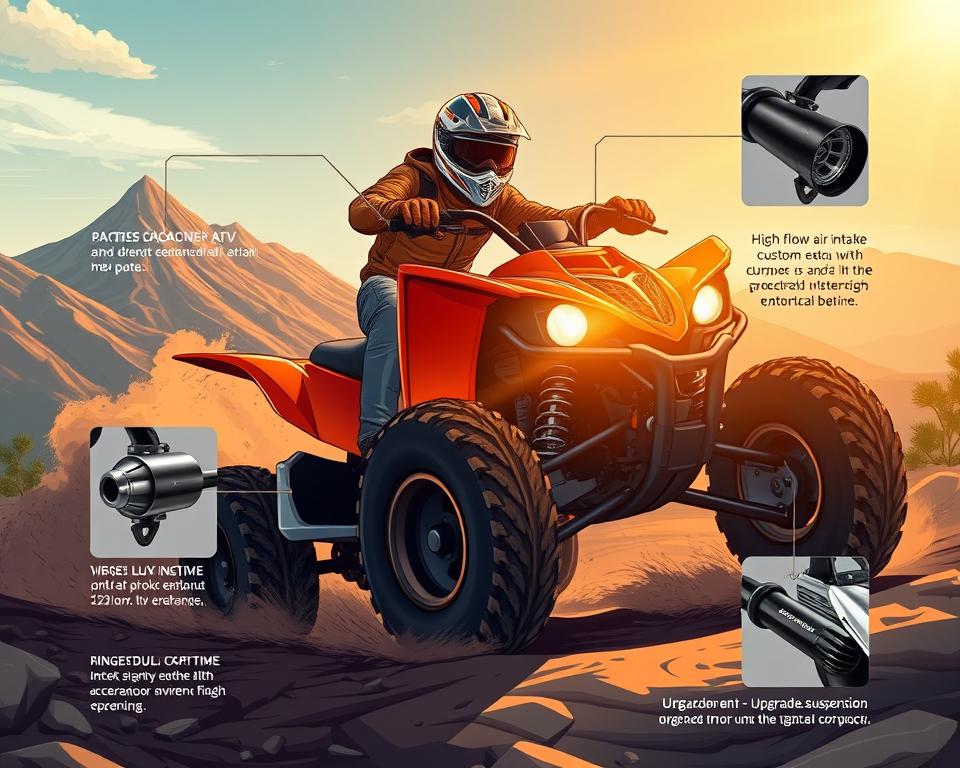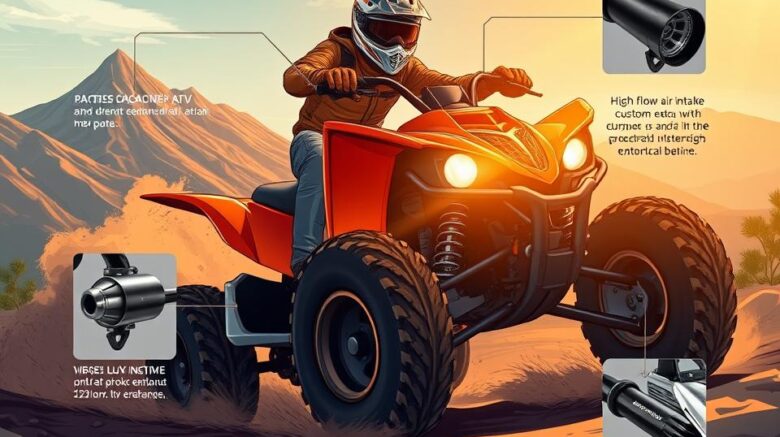Essential ATV Off-Road Checklist for Safe Riding
Have you heard nearly about 450,000 ATV-related injuries are treated in U.S. emergency rooms each year? That startling statistic underscores why off-road safety and preparation are essential. The Essential ATV Off-Road Checklist is your guide to a safe and enjoyable ride. It covers everything from rocky trails to sand dunes. With the right safety gear and canam plow essentials, you can minimize risks and boost your adventure.
Notable Observations
- Use this checklist first to prep safely and thoroughly.
- An ATV safety gear checklist is vital for protecting yourself during off-road rides.
- Keep your ATV running smoothly with routine care.
- Stay fueled and hydrated for peak performance.
- Learn to use navigation tools to avoid getting lost on off-road routes.
- Weather can flip fast—be ready with proper gear.
- Trailside fixes? Have your toolkit and recovery gear ready.
Understanding the Importance of Safety Gear
Safety is non-negotiable for every off-road trip. The excitement of ATVs brings potential hazards. Protective equipment shields you from crashes and bumps. Gear up correctly with this ATV safety gear checklist.

Essential Protective Gear
Maximizing protection involves several key items:
- Riding Helmets: Choose DOT-approved helmets to prevent head injuries.
- Goggles: Block dirt and grit with quality goggles.
- Riding Gloves: Grip and guard your hands with sturdy gloves.
- Boots: High boots shield your feet and ankles.
- Body Armor: Wear armor to guard your torso on rough trails.
- Neck Protection: A neck brace protects your spine in a crash.
Emergency Preparedness
Don’t overlook your emergency kit. An effective emergency kit can be a lifesaver in unexpected situations. Key items to include are:
- First aid kit
- Multi-tool
- Tire repair kits
- Portable air compressors
- Emergency blankets
- Whistles
- Matches
ATV Equipment for Optimal Performance
Gear choices affect how well your ATV runs. Pack these essentials for any trail. Use this maintenance checklist to keep your ride healthy.
Must-Have ATV Equipment
- All-Terrain Tires: Terrain-specific tires keep you glued to the track.
- Cargo Systems: Keep tools and spares within reach.
- Fuel Reservoir: Never run low—use a proven fuel tank.
- Medical Kit: Prepare for emergencies with a well-stocked first aid kit for immediate attention if needed.
Regular Maintenance for Longevity
Routine care keeps breakdowns at bay. Regular inspections should encompass:
- A clean air filter = a happy engine.
- Lubricating the chain to ensure optimal performance.
- Test your brakes on every pre-ride check.
Follow these steps to prep your ride for every trail.
The Essential ATV Off-Road Checklist
Preparing for a ride is more than just hopping on your ATV. An effective ATV maintenance checklist ensures your vehicle’s safety and performance. Every point matters—don’t rush. Spend a few minutes now for peace of mind later.
Pre-Ride Inspection Basics
Your pre-ride look-over sets the tone for safety. This quick evaluation helps riders identify and address issues before they start. Key elements to check include:
- Tire pressure and tread condition
- Fluid levels such as oil and fuel
- Brakes and controls functionality
- Operational lights and horn
- Chain or driveshaft integrity
T-CLOC Inspection Method
T-CLOC covers every critical system. It covers Tires and Wheels, Controls, Lights, Oil and Fuel, and Chain/Driveshaft. This method ensures all critical areas are covered:
| Inspection Area | Checklist Items |
|---|---|
| Tires and Wheels | Check tire pressure, inspect tread depth, look for damage |
| Controls | Test brakes, throttle, and clutch for smooth operation |
| Lights | Ensure headlights, brake lights, and indicators are functioning |
| Oil and Fuel | Check oil level, inspect for leaks, and fill fuel tank |
| Chain/Driveshaft | Examine for wear, proper tension, and lubrication |
Spending a few minutes on this ATV maintenance checklist can make rides safer and more enjoyable. By checking these essential components, riders can avoid breakdowns.
Hydration and Nutrition for Long Rides
Stay fueled and hydrated for peak performance. Always carry more water than you think you’ll need. Carry extra water to prevent fatigue and keep energy levels up during the adventure. Nutritious snacks power you through rough stretches.
Importance of Staying Hydrated
Hydration is critical for ATV riders to stay alert and capable throughout their journey. Sipping regularly prevents performance drops. Hydration bladders track consumption at a glance.
High-Energy Snacks to Pack
The right fuel makes the ride smoother. Choose items that won’t spoil in heat. Some ideal choices include:
- Protein bars
- Nut mixes
- Dried fruits
- Beef jerky
Snack smart for sustained energy. Mix sweet and salty options for flavor and function.
Navigation Tools for Off-Roading Adventures
Stay on course with proven navigation aids. Off-road navigation tools are invaluable for staying on track, no matter the terrain.
Advanced GPS Systems
Off-road GPS with offline maps keeps you safe. GPS should work without cell service and last all day. Brands like Garmin and TomTom offer models designed for off-road use, ensuring durability and precision.
Traditional Navigation Aids
Always carry a paper map along with your GPS. Waterproof maps and compasses are vital backups when your GPS fails. Knowing how to use these tools is critical, adding security to your excursions. Combining advanced tech with traditional aids prepares you for any situation on your journey.
Communication Equipment for Safety
When phones fail, two-way radios deliver. Using reliable ATV communication gear is vital for safety. Knowing you can call for help reduces stress.
Don’t split up without radios in hand. These devices ensure clear audio over long distances. They allow for real-time updates on any changes or hazards. When choosing two-way radios, look for models with:
- Rugged, waterproof design to resist the elements
- Extended run-time for extended trips without needing a recharge
- Multiple channels for clear communication without interference
No ride is complete without radios. Group comms save time and reduce risk. They provide a vital communication line in tough environments. With the right tools, your off-road trips will be smoother and more enjoyable.
Self-Rescue Gear for ATV Riders
Don’t be caught unprepared—pack rescue gear. With the right kit, you’ll tackle obstacles solo. Prepared riders make safer group members.
Winches and Recovery Kits
Winches are vital for self-rescue, helping pull your ATV from tough spots. Combine winch power with the right accessories. Recovery kits usually include:
- Tow straps
- D-rings
- Recovery boards
- Gloves
Practice recovery techniques before you need them. Don’t let stuck wheels end your ride.
Trail Recovery Essentials
Pack these extras along with your winch. These include:
| Equipment | Purpose |
|---|---|
| Recovery Straps | Used for towing or pulling ATVs out of tight situations. |
| Shovel | Helps clear obstacles and dig out vehicles when stuck. |
| Traction Mats | Provides grip under tires in muddy or slick conditions. |
| Portable Air Compressor | Enables quick tire inflation after deflating for better traction. |
Don’t rely on luck—bring the right tools. Practice rescues so you’re ready when it counts.
Staying Adaptable: Preparing for Weather Changes
Trail weather can change in minutes. It’s vital to be ready for sudden changes to stay safe and enjoy the ride. Don’t forget your layers and rain shell.
Layer up, shed as needed. A dry base keeps you cozy. Then, add insulating layers like fleece or wool that can be removed as needed. Your shell fights off wind and rain. This setup ensures you stay comfortable, no matter the weather.
Weather-Appropriate Clothing
- Rain Shells: Essential for keeping dry during unexpected rain showers.
- Breathable Pants: Pants that vent yet keep out the rain.
- Sun Protection: Lightweight, long-sleeved shirts and wide-brimmed hats safeguard against harmful UV rays.
- Cold-Weather Gloves: Warm gloves maintain dexterity in chill.
Gear up for every climate challenge. Stay focused on the trail, not on being wet or cold.
Tools for On-Trail Repairs
Having the right tools for on-trail repairs is key to a safe and enjoyable off-roading experience. It’s vital to carry reliable ATV repair tools. These tools help address minor breakdowns or issues that may arise during your adventure.
Must-Have Tools and Kits
A well-prepared rider should assemble a basic tool kit. This kit should include essential items for quick repairs. Critical ATV repair tools might include:
- Tire irons for changing flat tires
- Pliers for gripping and cutting
- Wrenches for various sizes of bolts and nuts
- A multi-tool for versatility
- Spare items such as spark plugs and electrical wire
- Duct tape for quick fixes
Having these tools readily available boosts confidence and autonomy while exploring off-road trails.
Basic Emergency Supplies
In addition to essential tools, packing basic emergency supplies for ATV is vital. These supplies help ensure your safety in challenging situations:
- First aid kit for injuries
- Flashlight with extra batteries for night-time visibility
- Emergency whistle for signaling assistance
- Reflective triangles or flares to warn other riders
- Water and high-energy snacks for sustenance
Preparedness significantly impacts your off-roading experience. Always keep these ATV repair tools and emergency supplies handy.
Wrapping It Up
Preparation is the secret to epic trails. Follow this checklist and choose quality gear. This ensures you’re ready for any terrain.
With the right protective gear, navigation tools, and communication equipment, you’re set for safe riding. Effective planning is vital for both safety and performance. Embrace excitement, ditch the doubts.
Gear up, stay sharp, and savor every off-road second. Every leg of the trip matters. By following the Essential ATV off-road checklist, you’re set for an incredible adventure in the great outdoors.
Frequently Asked Questions
What should I include in my ATV safety gear checklist?
Your ATV safety gear checklist should include a DOT-approved helmet and goggles. Don’t skip gloves, boots, and armor. Neck braces help guard your spine. Remember to pack an emergency kit with a first aid kit and multi-tools for preparedness.
How can I ensure my ATV is well-maintained?
Keep filters clean and chain well-lubed. Always test your brakes before a ride. A consistent maintenance routine extends your machine’s life and keeps it ready for off-road adventures.
Explain the T-CLOC check.
T-CLOC is a five-step pre-ride routine. Tires, Controls, Lights, Oil, and Chain are checked in T-CLOC. T-CLOC confirms all systems go for trail use.
How much water should I bring on an ATV trip?
Carrying more water than you think you’ll need is essential. Proper hydration wards off exhaustion. Hydro packs let you drink without stopping.
What should I bring for navigation during my off-road adventure?
For navigation, invest in an advanced GPS system designed for off-road use. Also carry a compass and laminated maps.
Role of radios on the trail?
Comms keep groups connected and safe. Radios work where phones don’t.
Must-have self-rescue tools?
Be ready with winch and recovery essentials. Have straps, shackles, mats, and gloves on hand.
Tips for weather readiness off-road?
Use a base, mid, and shell layering system. Pack a rain shell to stay dry. Don’t forget sunscreen and UV-blocking apparel.
Which trailside tools matter most?
Carry essential wrenches, pliers, and irons. Don’t forget duct tape and electrical wire.
